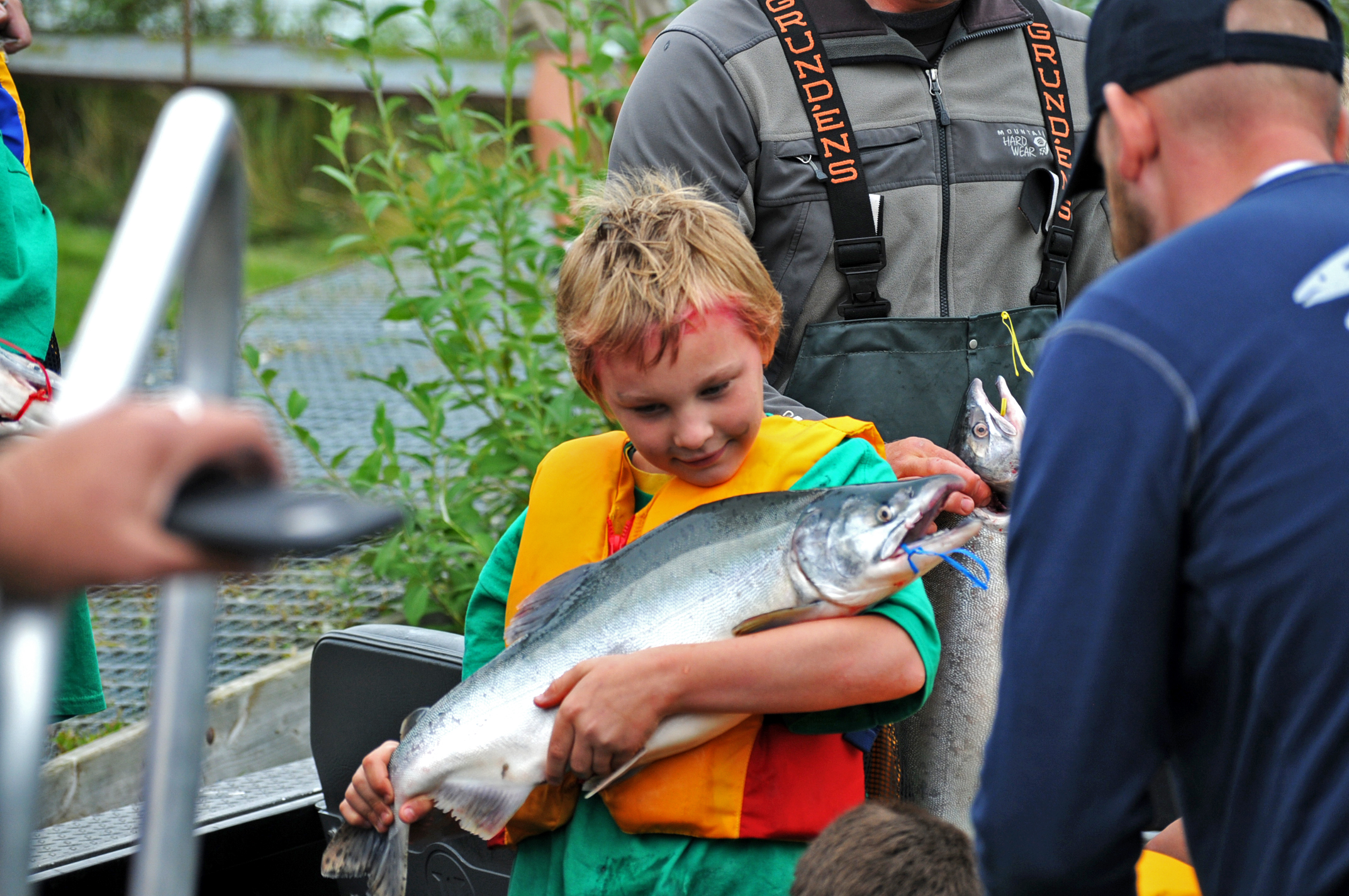Boat after boat full of kids came to dock at the Harry Gaines Fish Camp Wednesday, where proud kids held up their catch of pink or silver salmon.
The 11th annual Kenai River Junior Classic event brought kids from Kenai, Soldotna, Anchorage and elsewhere to the Kenai River for boating safety education, fish and river ecology lessons and a chance to fish for salmon with licensed guides. When they pulled back into the dock, some held up silver salmon, and many held up fish with the characteristic hump of pink salmon.
After the rush on the Kenai for sockeye and king salmon, coho take over most of the effort. However, the fishing has stayed slow so far, with few of the silver salmon being spotting in the Alaska Department of Fish and Game’s netting projects on the Kenai River, said Jason Pawluk, the acting area management biologist for the Division of Sportfish in Soldotna.
Fish and Game does not run enumerate the coho on the Kenai River. So far, the reports coming in from guide logbooks show that fishing success for coho is low. The test nets have been coming back with between zero and two coho per day, he said. However, things may look up — on Tuesday, the net came back with 20 coho, which could be either a single spike or an indication that more fish are making their way upriver.
“Silver fishing is slow, but there might be some good news- yesterday, our netters, who were only averaging between zero and two coho per day, yesterday got 20,” he said. “I haven’t heard of any reports today of people fishing, but that might be a sign of some entry of coho into the lower river.”
The majority of the fish available in the river right now are pink salmon. Pinks, though less desirable because of their smaller size and tendency for their meat to degrade quickly, can be fun to catch — they bite at nearly anything and anglers are likely to hook into many of them. Fish and Game does not enumerate the pink salmon runs either, but the runs are reportedly much larger on even years in Cook Inlet.
The pink salmon have been reportedly large this year, as well. Usually, pinks are some of the smallest salmon, ranging between three and a half to four pounds. In the commercial fishery, the numbers have been showing some days with pink salmon an average of six pounds.
In the river, pinks caught in the lower river and near the mouth tend to have better meat quality because they are still ocean-bright, Pawluk said.
“Pink fishing is excellent,” Pawluk said. “The pinks being caught are still of good quality. We’ve seen some really nice bright ones still.”
Sockeye fishing on the Kenai is still possible, though it’s wound down significantly, he said. The counts have stayed below 30,000 per day past the sonar for the past four days or so, with a total cumulative count of nearly 1.2 million in the river so far. Sockeye fishing has been spotty on the Russian River, with some days counting more than 1,000 fish through the weir per day. The Kasilof River has four more days of counts left, but the Division of Commercial Fisheries downgraded its forecast for the Kasilof last week by about 260,000 fish, with less than 4,000 fish passing the sonar each day.
The counts for the Kenai River late-run king salmon were revised last week due to a spreadsheet error. The sonar counts king salmon of all sizes and age classes, but the error only applied to the estimate for fish less than 34 inches long. Because of the error, the total number of king salmon is actually 1,900 less than the original number reported, according to a memo from Fish and Game issued Aug. 2.
Each season, to accommodate for where fish are moving in the river, Fish and Game staff move the sonar transducers in the river to make sure all the fish are accurately counted. When the staff moved the transducer this year, they did not correct the mixture model to account for the different sizes of salmon passing the sonar. When the staff realized the sonar counts didn’t match the data Fish and Game was getting from its netting project, they began to figure out the error, Pawluk said.
Even with the error, the department’s management decisions stand, he said. It would not have affected the department’s readjustment of the projection to fall less than 22,500, but the lower end of the escapement goal has already been met, he said.
“It did not change our management at the end of the fishery, and it would not have changed our management inseason in the fishery,” Pawluk said.
Reach Elizabeth Earl at elizabeth.earl@peninsulaclarion.com.

